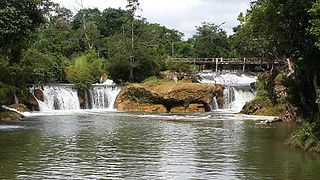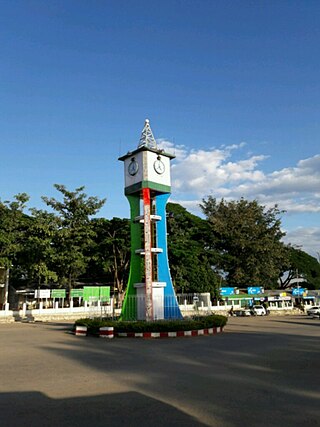Related Research Articles

Wolframite is an iron, manganese, and tungstate mineral with a chemical formula of (Fe,Mn)WO4 that is the intermediate mineral between ferberite (Fe2+ rich) and hübnerite (Mn2+ rich). Along with scheelite, the wolframite series are the most important tungsten ore minerals. Wolframite is found in quartz veins and pegmatites associated with granitic intrusives. Associated minerals include cassiterite, scheelite, bismuth, quartz, pyrite, galena, sphalerite, and arsenopyrite.

Kayah State, or Karenni State, is a state of Myanmar. Situated in eastern Myanmar, it is bounded on the north by Shan State, on the east by Thailand's Mae Hong Son Province, and on the south and west by Kayin State. It lies approximately between 18° 30′ and 19° 55′ north latitude and between 96° 50′ and 97° 50′ east longitude. The area is 11,670 km2 (4,510 sq mi). Its capital is Loikaw. The estimated population in the 2014 Myanmar Census was 286,738, the smallest among Myanmar's seven states. It is inhabited primarily by the Karenni ethnic group, also known as Red Karen or Kayah, a Sino-Tibetan people.

The tin mining industry on Dartmoor, Devon, England, is thought to have originated in pre-Roman times, and continued right through to the 20th century, when the last commercially worked mine closed in November 1930. From the 12th century onwards tin mining was regulated by a stannary parliament which had its own laws.

The Economy of the Empire of Japan refers to the period in Japanese economic history in Imperial Japan that began with the Meiji Restoration in 1868 and ended with the Surrender of Japan in 1945 at the end of World War II. It was characterized by a period of rapid industrialization in the late nineteenth and early twentieth centuries, and the dominance of a wartime economy from 1938 to 1945.

Loikaw is the capital of Kayah State, also known as Karenni State, in Myanmar. It is located in the Karen Hills area, near the State's northern tip, just above an embayment on the Pilu River. The inhabitants are mostly Kayah (Karenni). Myanmar's largest hydropower plant is located about 20 km (12 mi) east of Loikaw at Lawpita Falls.

The Karenni States, also known as Red Karen States, was the name formerly given to the states inhabited mainly by the Red Karen, in the area of present-day Kayah State, eastern Burma. They were located south of the Federated Shan States and east of British Burma.

Greisen is a highly altered granitic rock or pegmatite, usually composed predominantly of quartz and micas. Greisen is formed by self-generated alteration of a granite and is a class of moderate- to high-temperature magmatic-hydrothermal alteration related to the late-stage release of volatiles dissolved in a magma during the solidification of that magma.

Mining in Cornwall and Devon, in the southwest of Britain, is thought to have begun in the early-middle Bronze Age with the exploitation of cassiterite. Tin, and later copper, were the most commonly extracted metals. Some tin mining continued long after the mining of other metals had become unprofitable, but ended in the late 20th century. In 2021, it was announced that a new mine was extracting battery-grade lithium carbonate, more than 20 years after the closure of the last South Crofty tin mine in Cornwall in 1998.

The Karenni, also known as the Kayah or Kayah Li, are a Karen people native to the Kayah State of Myanmar (Burma).

Drakelands Mine, also known as Hemerdon Mine or Hemerdon Ball Mine, is a tungsten and tin mine. It is located 11 km northeast of Plymouth, near Plympton, in Devon, England. It lies to the north of the villages of Sparkwell and Hemerdon, and adjacent to the large china clay pits near Lee Moor. The mine had been out of operation since 1944, except for the brief operation of a trial mine in the 1980s. Work started to re-open it in 2014, but it ceased activities in 2018. It hosts the fourth largest tin-tungsten deposit in the world.

SAG/SDAG Wismut was a uranium mining company in East Germany during the time of the Cold War. It produced a total of 230,400 tonnes of uranium between 1947 and 1990 and made East Germany the fourth largest producer of uranium ore in the world at the time. It was the largest single producer of uranium ore in the entire sphere of control of the USSR. In 1991 after German reunification it was transformed into the Wismut GmbH company, owned by the Federal Republic of Germany, which is now responsible for the restoration and environmental cleanup of the former mining and milling areas. The head office of SDAG Wismut / Wismut GmbH is in Chemnitz-Siegmar.

Tajikistan has rich deposits of gold, silver, and antimony. The largest silver deposits are in Sughd Province, where Tajikistan's largest gold mining operation is also located. Russia's Norilsk nickel company has explored a large new silver deposit at Bolshoy Kanimansur. More than 400 mineral deposits of some 70 different minerals have been discovered in Tajikistan, including strontium, tungsten, molybdenum, bismuth, salt, lead, zinc, fluorspar, and mercury. These minerals have been found suitable for mining. Uranium, an important mineral in the Soviet era, remains in some quantity but is no longer being extracted. The Tajikistan Aluminium Company (TALCO), an aluminium smelter, is the country's only large-scale production enterprise in the mining sector. Tajikistan hosts the annual Mining World Tajikistan, an international exhibition on mining in Dushanbe.
Adex Mining Inc. is a Toronto, Ontario, Canada-based mining exploration company engaged in the development of its wholly owned Mount Pleasant Mine property in Charlotte County, New Brunswick, Canada. According to the Government of Canada report, Mount Pleasant is "North America's largest tin deposit and the world's largest reserve of indium." The company's stock trades on the TSX Venture Exchange under the symbol ADE.

Mining in the United Kingdom produces a wide variety of fossil fuels, metals, and industrial minerals due to its complex geology. In 2013, there were over 2,000 active mines, quarries, and offshore drilling sites on the continental land mass of the United Kingdom producing £34bn of minerals and employing 36,000 people.
The Mittersill mine (also known as Felbertal Mine) is a large mine located south of the Mittersill town, in the State of Salzburg in western Austria, 30 kilometres (19 mi) South of Kitzbühel and some 340 kilometres (210 mi) southwest of the capital, Vienna. Mittersill is the largest scheelite deposit in Europe, having in 2010 estimated reserves of 6.1 million tonnes of ore grading 0.5% pure tungsten. The mine produces around 500.000 t ore grading 0.3 %WO3, i.e., around 1,200 tonnes of WO3 per year (data from 2010 to 2017).
Mining in North Korea is important to the country's economy. North Korea is naturally abundant in metals such as magnesite, zinc, tungsten, and iron; with magnesite resources of 6 billion tonnes, particularly in the North and South Hamgyong Province and Chagang Province. However, often these cannot be mined due to the acute shortage of electricity in the country, as well as the lack of proper tools to mine these materials and an antiquated industrial base. Coal, iron ore, limestone, and magnesite deposits are larger than other mineral commodities. Mining joint ventures with other countries include China, Canada, Egypt, and South Korea.
The Oortsog Ovoo mine is a large open pit mine located in the central part of Mongolia. Oortsog Ovoo represents one of the largest tin reserves in Mongolia having estimated reserves of 196 million tonnes of ore grading 0.02% tin. The Oortsog Ovoo skarn-type tin deposit : Prospecting work was carried out between 1986 and 1989 and 1990. The four cassiterite bearing skarn ore bodies are located in Upper Proterozoic, Upper JurassicLower Cretaceous rocks intruded by Late Paleozoic and Middle-Late Jurassic granites. The magnetite-rich skarn ore bodies are 75–150 m long, 1–32 m thick and 30–150 m deep. The grade varies between 0.5 and 2.18 % Sn, with minor amounts of Zn and Cu, and Au.

The mining industry of Uganda, documented as early as the 1920s, witnessed a boom in the 1950s with a record 30 percent of the country's exports. It received a further boost when mining revenues increased by 48 percent between 1995 and 1997. However, the World Bank reported that the sector's contribution to gross domestic product (GDP) dropped from 6 percent during the 1970s to below 0.5 percent in 2010. Uganda's extractive industry activities have been identified by the Natural Resource Governance Institute as focused on "extraction of cobalt, gold, copper, iron ore, tungsten, steel, tin and other industrial products such as cement, diamonds, salt and vermiculite". Limestone is sold in local markets whereas gold, tin, and tungsten are major exports.
The Sable Tin Deposit also known as "Sobolinoye" is a high grade tin-copper deposit located in the Solnechny District of Khabarovsk Krai in the Russian Far East. Discovered in 1964 on the basis of 1:5000 – 1:10000 mapping which identified the presence of commercial concentrations of tin at surface. It is located within the Komsomolsk Ore (Tin) District, a major tin region within Russia with both historical and current mining activities. The deposit's resources were registered in 1987 and Technical Economic Conditions for design and construction were prepared by Gipronickel, a Norilsk subsidiary in 1993 but due to economic and political turbulence the deposit was never developed or exploited
Operation 1111 is an ongoing military operation launched by Karenni Ethnic Armed Organisations (EAOs) including the Karenni Army (KA), Karenni Nationalities Defence Force (KNDF) and Karenni National People's Liberation Front (KNPLF). The operation was launched concurrently with Operation 1107, with the goal to capture Kayah State's capital city of Loikaw.
References
- ↑ Myint, A.Z.; Yonezu, K.; Boyce, A.J.; Selby, D.; Schersten, A.; Tindell, T.; Watanabe, K.; Swe, Y.M. (2018). "Stable isotope and geochronological study of the Mawchi Sn-W deposit, Myanmar: Implications for timing of mineralization and ore genesis". Ore Geology Reviews. Retrieved 11 July 2021.
- ↑ Allen, Louis (1984). Burma: The Longest War 1941-45. London: Phoenix Press. p. 7. ISBN 9781842122600.
- ↑ "Karenni Resistance Forces Capture Mawchi Town, Control Critical Mining Areas". Burma News International. Retrieved 2024-03-05.